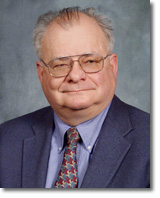About
In Memoriam: John R. Murray,
Jun 02, 2013
In Memoriam: John R. Murray, 1943-2013
 John R. Murray, an OSA Fellow and a member of the Society for more than thirty years, passed away on 2 June 2013. He was 70.
John R. Murray, an OSA Fellow and a member of the Society for more than thirty years, passed away on 2 June 2013. He was 70.
Murray received B.S. and Ph.D. degrees in Physics from the Massachusetts Institute of Technology (MIT) in 1965 and 1970. As an undergraduate student, he became involved in scientific research in the early days of lasers. After two years in the U.S. Army, Murray joined Lawrence Livermore National Laboratory (LLNL) in Livermore, California, where he worked in the laser fusion program until retiring in 2003. His work focused on KrF and neodymium glass laser technology, and he had a major role in the design of the laser system for the Livermore National Ignition Facility (NIF), a megajoule-class laser facility for inertial fusion and other high temperature physics research. He later served as a senior scientist in the systems engineering group for the NIF.
Murray was affectionately known as “Dr. Science” around the laser program at NIF for many years. His encyclopedic knowledge of everything ‘laser’ and his knack for clear explanation probably began with his participation in the original study of the quantum statistics of amplitude fluctuations in the very first gas lasers. At LLNL, Murray developed RAPIER (Raman Amplifier Pumped by Intensified Excimer Radiation) technology to study techniques for compressing rare-gas-halide laser pulses efficiently by combining the Raman effect with pulse stacking. The RAPIER Laser was successfully deployed and tested at the kilojoule energy level by Murray and Julius Goldhar in 1983 at LLNL. Murray also developed a krypton fluoride (KrF) excimer laser, and the resulting publication is still often cited by KrF laser enthusiasts.
Murray and Mark Henesian at LLNL were the first to observe and quantify the effects of stimulated rotational Raman scattering (SRRS) from molecular nitrogen in long air paths and the extreme beam filamentation from this effect in atmospheric propagation. Murray was the lead member of a team with Henesian and Jeff Paisner in the study of atmospheric SRRS for the Star Wars Program at LLNL. Murray and the laser science team on NOVA also discovered transverse stimulated Brillouin scattering and the related optical damage at the third harmonic wavelength in large aperture fused silica optics, using the new NOVA prototype Type I/ Type II harmonic crystal array. As a chief scientist, Murray was a key member of the NIF laser design team from its conception, through its successful commissioning. He led the beam smoothing working group with colleagues Sham Dixit and Henesian and guided many NIF design efforts.
Several of Murray’s publications remain highly cited to this day, including “Raman Pulse-Compression of Excimer Lasers for Application to Laser Fusion,” (IEEE Journal of Quantum Electronics (Vol. 15, Issue 5, 1979), co-authored by J. Goldhar and D. Eimerl et al; and “National Ignition Facility Laser Performance Status,” (Applied Optics, Vol. 46, Issue 16, 2007), co-authored by C. A. Haynam, P. Wegner, and J. Auerbach.
An OSA member since 1982, Murray began his association with OSA publications in 1984 as a topical editor for JOSA B. In 1991 he became a divisional editor for Applied Optics, and he served as editor-in-chief from 1993-1999. He served as chair of the OSA Publications Council (2000-2002) and as a member of the OSA Board of Directors (2001-2002). Murray was elected a Fellow of OSA in 1993.
Murray enjoyed his family, photography, woodworking and carpentry. In addition to his many accomplishments, he will be especially remembered for his great vision and mentoring and encouragement of young scientists, and as a kind and empathetic friend to all. He will be sincerely missed by his family, many friends and many past colleagues.
If you would like to make a memorial donation to the OSA Foundation in honor of John R. Murray, please visit www.osa.org/donate.
